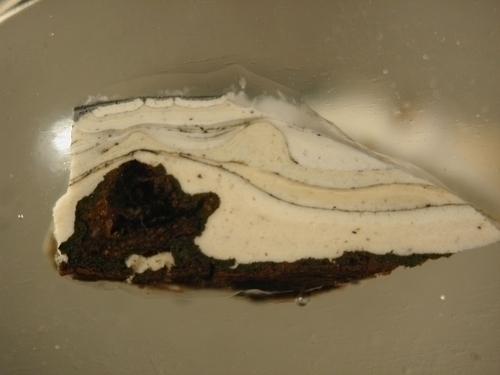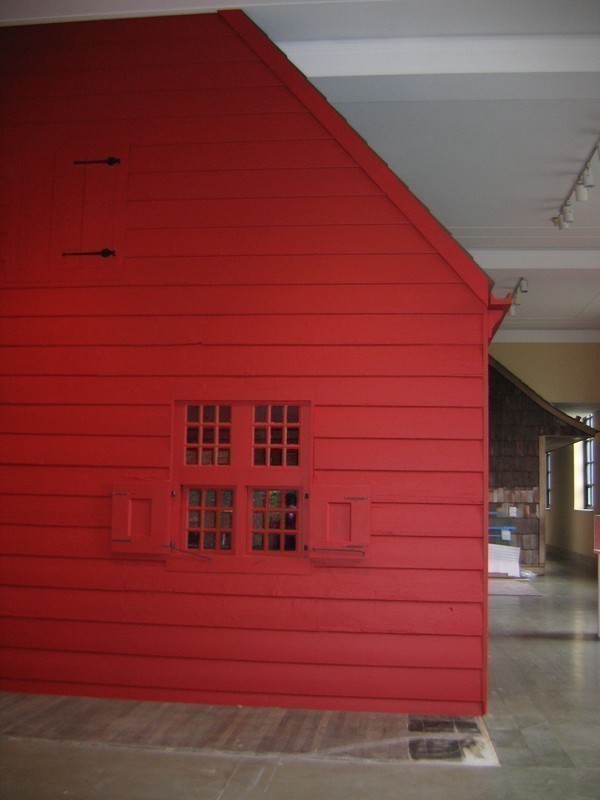Why did we paint the Schenck House red?
The Jan Martense Schenck House is scheduled to re-open to the public in July. It has moved from its original location on the 4th floor to a new location that situates it next to the house of Nicholas Schenck, the grandson of Jan Martense. For those of you who have been coming to the Brooklyn Museum to visit the house since you were kids, and for those of you who have been bringing your children to visit the house, you may notice a bigger difference than simply the change in location. The house, formerly a dark blue when first installed at the Museum has been entirely re-painted deep red, including the trim!
The Jan Martin Schenck House came into the collection in 1950, and was assembled in the 1960’s on the 4th floor of the Museum in the location that is currently occupied by Judy Chicago’s The Dinner Party. When assembled at the Museum, some of the wooden siding was included in the architectural components, but new siding had to be reproduced at the museum to completely finish the house. At that time, the house was painted dark blue, with a white trim.
To make way for the construction of The Elizabeth Sackler Center for Feminist Art which houses The Dinner Party, The Schenck House was disassembled and moved. Jim Boorstein of Traditional Line, an architectural conservation firm, was contracted to undertake this part of the project.

Detail of paint cross section showing the lowest red, and green paint layers, followed by several layers of white.
So why did we change the color from the dark blue to barnyard red? Obviously, any wooden frame house that remained standing in Brooklyn from the 17th century to the early 20th, would have been repaired and repainted numerous times as part if its maintenance and up-keep. In trying to understand the paint scheme, we took paint cross sections from the oldest existing pieces of wood siding that were present. This is a way to see what was the paint layer sequence. A small piece of paint is mounted into resin and polished smooth so that the layers can be seen in cross section underneath a polarizing light microscope. This work was done for us by Jamie Martin at Orion Analytical.
It needs to be said that we do not know the age of the wooden siding, and it is unlikely that it is part of the original siding from 1675-1677 when the house was thought to have been built, but it was a place to start.
Our original question was, “Why did they paint the Schenck House blue in the 1960’s installation?”. In examining the cross section, we found no evidence of a blue paint layer in the oldest existing paint from the house. Underneath the uppermost blue layer, which was applied by the Museum, were many layers of white paint, followed by a broken up green layer and an equally distressed red layer directly on top of the wood siding.
Consulting with Dr. Barry Harwood, Curator of Decorative Arts, it was thought that the numerous layers of white represent the painting scheme from the 19th c. onwards, as white was a popular color to paint a wood frame house, during that time period. The green and the red layers could therefore represent the colors the house was painting in the time before the 19thc. From this physical evidence on the cross section, and with the Curatorial expertise provided by Dr. Harwood, regarding the history of 17th and 18th c. houses, the Museum came to the decision to repaint the house red, to represent the oldest known existing paint color.
Dr. Harwood, and Museum Designer Lance Singletary worked with the Museum’s painters to achieve a color and a surface texture that would be in keeping with 17th c. housing painting practices.
We hope you enjoy visiting the newly painted, and newly installed house!
Lisa Bruno, Objects Conservator

Lisa Bruno is the head conservator of objects at the Brooklyn Museum, where she has been working since 1993. She has previously worked at the Art Institute of Chicago, and has had internships at The Cleveland Museum of Art, the Detroit Institute of Arts, and in private practice. She has a Masters Degree in Art Conservation from the University of Delaware, Winterthur Museum Art Conservation Department. She is a Professional Associate of the American Institute for Conservation.

